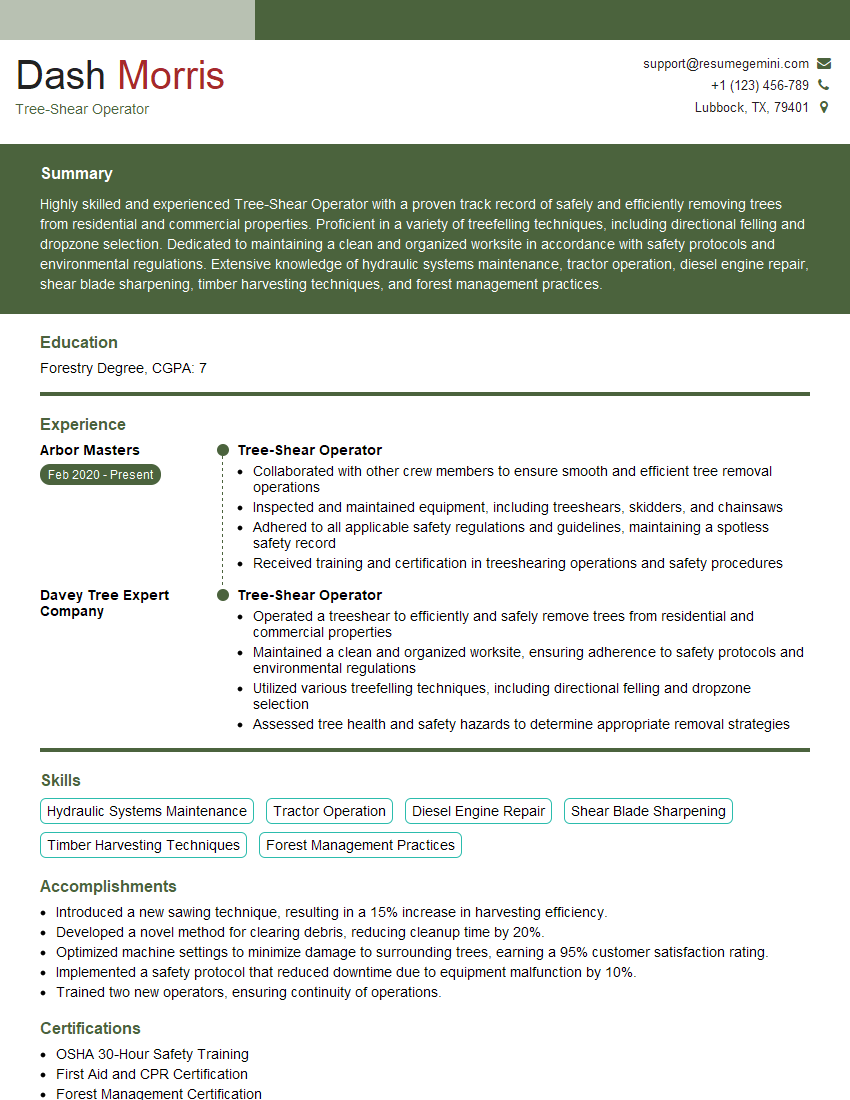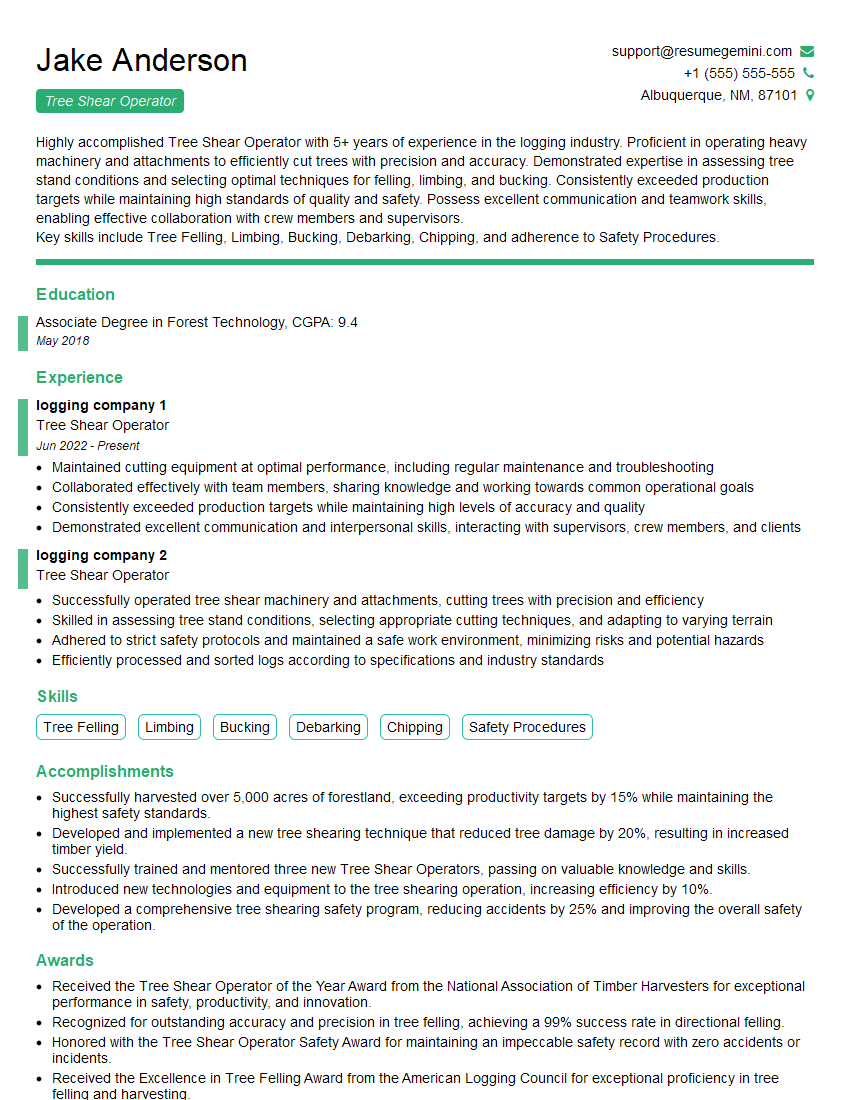Are you gearing up for a career in Tree-Shear Operator? Feeling nervous about the interview questions that might come your way? Don’t worry, you’re in the right place. In this blog post, we’ll dive deep into the most common interview questions for Tree-Shear Operator and provide you with expert-backed answers. We’ll also explore the key responsibilities of this role so you can tailor your responses to showcase your perfect fit.
Acing the interview is crucial, but landing one requires a compelling resume that gets you noticed. Crafting a professional document that highlights your skills and experience is the first step toward interview success. ResumeGemini can help you build a standout resume that gets you called in for that dream job.
Essential Interview Questions For Tree-Shear Operator
1. Tell me about your experience in Tree Shearing?
- I have been working as a tree shear operator for the past 5 years.
- I have experience in shearing trees of all sizes and types.
- I am also experienced in using a variety of tree shearing equipment.
2. What are the different types of tree shearing equipment that you are familiar with?
Hydraulic shears
- Hydraulic shears are powered by hydraulic fluid.
- They are the most common type of tree shear.
- Hydraulic shears are powerful and can cut through large branches.
Pneumatic shears
- Pneumatic shears are powered by compressed air.
- They are lighter and more portable than hydraulic shears.
- Pneumatic shears are not as powerful as hydraulic shears.
3. What are the safety precautions that you take when shearing trees?
- I always wear proper safety gear, including a hard hat, safety glasses, and gloves.
- I inspect my equipment before each use to make sure it is in good working order.
- I am always aware of my surroundings and make sure that there are no people or obstacles in the area before I start shearing.
- I never shear a tree that is too large or too close to power lines.
4. What are the different types of tree cuts that you can make?
- Flush cut: A flush cut is made at the base of the branch, removing the branch from the tree.
- Drop cut: A drop cut is made at the end of the branch, allowing the branch to fall to the ground.
- Heading cut: A heading cut is made to reduce the height or width of a tree.
- Thinning cut: A thinning cut is made to remove small branches from the interior of a tree.
5. How do you determine the best type of cut to make on a tree?
- I consider the size and location of the branch.
- I also consider the overall health of the tree.
- I always make sure that the cut I make is clean and precise.
6. What are the different types of trees that you have experience shearing?
- I have experience shearing a variety of trees, including oak, maple, pine, and fir.
- I am also experienced in shearing trees that are diseased or damaged.
7. How do you handle a tree that is leaning or has a large branch that is hanging?
- I always assess the situation carefully before I start shearing.
- If the tree is leaning, I will use a rope or cable to secure it before I start shearing.
- If the tree has a large branch that is hanging, I will use a ladder or lift to reach the branch and shear it off.
8. What are the different types of tree shear attachments that you are familiar with?
- There are a variety of tree shear attachments available, including:
- Fixed blades: Fixed blades are permanently attached to the shear.
- Interchangeable blades: Interchangeable blades can be changed out to accommodate different types of cuts.
- Rotating blades: Rotating blades spin as they cut, which makes them ideal for cutting through large branches.
9. How do you maintain your tree shear equipment?
- I perform regular maintenance on my tree shear equipment, including:
- Lubricating all moving parts.
- Checking the hydraulic fluid level.
- Sharpening the blades.
- Inspecting the equipment for any damage.
10. What are the different types of tree shearing techniques that you use?
- I use a variety of tree shearing techniques, including:
- Top-down shearing: Top-down shearing is a technique where I start at the top of the tree and work my way down.
- Bottom-up shearing: Bottom-up shearing is a technique where I start at the bottom of the tree and work my way up.
- Inside-out shearing: Inside-out shearing is a technique where I start at the interior of the tree and work my way out.
Interviewers often ask about specific skills and experiences. With ResumeGemini‘s customizable templates, you can tailor your resume to showcase the skills most relevant to the position, making a powerful first impression. Also check out Resume Template specially tailored for Tree-Shear Operator.
Career Expert Tips:
- Ace those interviews! Prepare effectively by reviewing the Top 50 Most Common Interview Questions on ResumeGemini.
- Navigate your job search with confidence! Explore a wide range of Career Tips on ResumeGemini. Learn about common challenges and recommendations to overcome them.
- Craft the perfect resume! Master the Art of Resume Writing with ResumeGemini’s guide. Showcase your unique qualifications and achievements effectively.
- Great Savings With New Year Deals and Discounts! In 2025, boost your job search and build your dream resume with ResumeGemini’s ATS optimized templates.
Researching the company and tailoring your answers is essential. Once you have a clear understanding of the Tree-Shear Operator‘s requirements, you can use ResumeGemini to adjust your resume to perfectly match the job description.
Key Job Responsibilities
Tree-Shear Operators perform a crucial role in harvesting operations, operating specialized machinery to fell trees and prepare them for processing. Their primary responsibilities include:
1. Tree Felling
Safely and efficiently fell trees of various sizes and species using a tree shear attached to a crawler tractor or other heavy equipment.
2. Hazard Assessment
Conduct thorough risk assessments to identify and mitigate potential hazards during tree felling operations, considering factors such as tree condition, lean, and surrounding obstacles.
3. Site Preparation
Clear and level the felling site to ensure safe operation and minimize damage to surrounding vegetation and infrastructure.
4. Timber Processing
Trim branches and remove logs from the felled trees to prepare them for further processing and transportation.
5. Equipment Maintenance
Perform regular maintenance and repairs on the tree shear and associated equipment to ensure optimal performance and safety.
Interview Tips
Preparing thoroughly for your Tree-Shear Operator interview is essential to showcase your skills and increase your chances of success. Here are some valuable tips to guide you:
1. Research the Company and Industry
Familiarize yourself with the company’s operations, values, and the industry trends to demonstrate your genuine interest and understanding of the field.
2. Highlight Your Experience and Skills
Emphasize your previous experience as a Tree-Shear Operator or in related roles, showcasing your proficiency in tree felling techniques, hazard assessment, and equipment handling.
3. Prepare for Technical Questions
Anticipate and prepare for technical questions related to tree felling safety procedures, equipment specifications, and timber processing methods.
4. Showcase Your Safety Consciousness
Tree felling involves inherent risks, so highlight your commitment to safety by describing your adherence to best practices and regulations.
5. Demonstrate Your Physical Fitness
Tree-shear operators must be physically fit to handle the strenuous demands of the job. Emphasize your ability to work in challenging conditions and maintain a high level of physical activity.
6. Practice Your Communication Skills
Effective communication is vital for coordinating with team members and conveying information clearly. Practice your ability to communicate instructions, observations, and any potential hazards.
7. Prepare Example-Based Responses
Using the STAR (Situation, Task, Action, Result) method, prepare examples of your accomplishments, highlighting your problem-solving abilities, teamwork, and attention to detail.
8. Be Punctual and Professional
Arrive on time for your interview and dress appropriately to create a positive first impression. Maintain a professional demeanor throughout the interview.
Next Step:
Now that you’re armed with a solid understanding of what it takes to succeed as a Tree-Shear Operator, it’s time to turn that knowledge into action. Take a moment to revisit your resume, ensuring it highlights your relevant skills and experiences. Tailor it to reflect the insights you’ve gained from this blog and make it shine with your unique qualifications. Don’t wait for opportunities to come to you—start applying for Tree-Shear Operator positions today and take the first step towards your next career milestone. Your dream job is within reach, and with a polished resume and targeted applications, you’ll be well on your way to achieving your career goals! Build your resume now with ResumeGemini.

